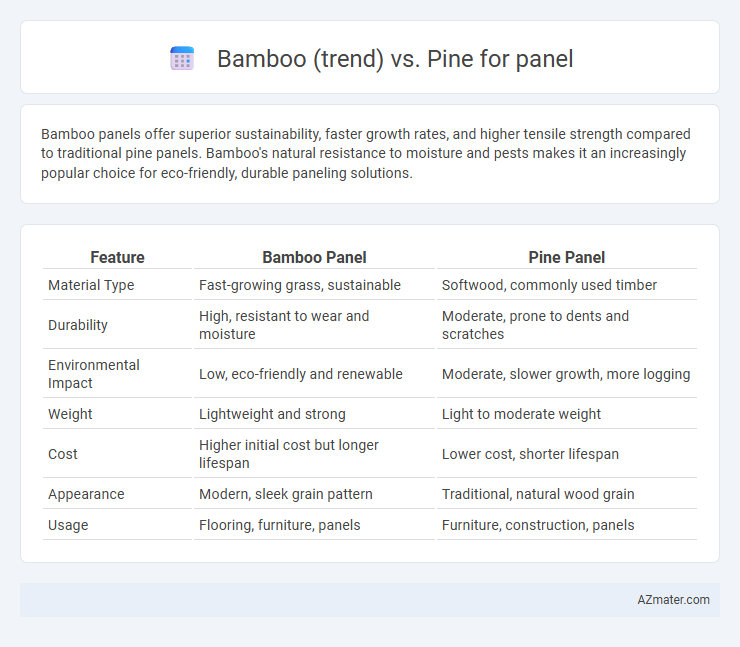Bamboo panels offer superior sustainability, faster growth rates, and higher tensile strength compared to traditional pine panels. Bamboo's natural resistance to moisture and pests makes it an increasingly popular choice for eco-friendly, durable paneling solutions.
Table of Comparison
| Feature | Bamboo Panel | Pine Panel |
|---|---|---|
| Material Type | Fast-growing grass, sustainable | Softwood, commonly used timber |
| Durability | High, resistant to wear and moisture | Moderate, prone to dents and scratches |
| Environmental Impact | Low, eco-friendly and renewable | Moderate, slower growth, more logging |
| Weight | Lightweight and strong | Light to moderate weight |
| Cost | Higher initial cost but longer lifespan | Lower cost, shorter lifespan |
| Appearance | Modern, sleek grain pattern | Traditional, natural wood grain |
| Usage | Flooring, furniture, panels | Furniture, construction, panels |
Overview of Bamboo and Pine as Panel Materials
Bamboo panels exhibit exceptional sustainability due to rapid growth and carbon sequestration, making them an eco-friendly alternative to traditional wood panels. Pine panels are favored for their affordability, ease of workability, and natural aesthetic, often used in interior applications and furniture. Bamboo offers superior strength-to-weight ratio and natural resistance to moisture, while pine provides more uniform grain and greater availability in varied thicknesses.
Sustainability: Bamboo vs Pine
Bamboo panels offer superior sustainability compared to pine, as bamboo is a rapidly renewable resource with a growth cycle of 3-5 years, significantly shorter than pine's 20-30 years. Bamboo's high carbon sequestration capacity contributes to lower environmental impact during production, making it an eco-friendly choice for paneling. In contrast, pine harvesting requires longer forest regeneration periods, impacting biodiversity and contributing to deforestation concerns.
Growth Rate and Harvesting Efficiency
Bamboo exhibits a rapid growth rate, reaching maturity within 3 to 5 years, significantly faster than pine, which typically takes 20 to 30 years to mature, enhancing panel production efficiency. Bamboo's high yield per hectare and ability to regrow after harvesting without replanting increase harvesting efficiency, reducing both labor costs and environmental impact compared to pine forestry. Pine panels, while traditional, face longer cycle times and higher resource input, making bamboo a sustainable and economically advantageous alternative for panel manufacturing.
Durability and Strength Comparison
Bamboo panels exhibit superior durability and tensile strength compared to pine, making them a preferred choice for high-traffic or moisture-prone environments. Bamboo's rapid growth and dense fiber structure provide enhanced resistance to warping, cracking, and insect damage, outperforming pine's softer and more porous composition. Pine, while easier to work with and cost-effective, generally requires additional treatments to achieve comparable longevity and structural integrity as bamboo.
Environmental Impact and Carbon Footprint
Bamboo panels offer a significantly lower environmental impact compared to pine due to their rapid growth rate, enabling faster carbon sequestration and reducing deforestation pressure on natural forests. Bamboo cultivation requires minimal pesticides and fertilizers, promoting sustainable land use and preserving biodiversity, whereas pine plantations often involve intensive chemical treatments. The carbon footprint of bamboo panels is substantially smaller, as their production emits less greenhouse gases and bamboo's natural durability reduces the need for frequent replacements.
Design Versatility and Aesthetic Appeal
Bamboo panels offer exceptional design versatility with their natural grain patterns and ability to be stained or laminated in various finishes, making them ideal for modern and eco-friendly interiors. Pine panels provide a classic, warm aesthetic with visible knots and a softer texture, enhancing rustic or traditional decor while allowing for easy customization through painting or staining. Both materials blend durability with visual appeal, but bamboo's sustainable origin and contemporary look often cater to innovative design trends seeking both style and environmental consciousness.
Cost Analysis: Bamboo Panels vs Pine Panels
Bamboo panels generally offer a cost-effective alternative to pine panels due to bamboo's rapid growth rate and sustainable harvesting, which reduces raw material expenses. Pine panels, while typically less expensive upfront, may incur higher long-term costs related to maintenance and susceptibility to pests or moisture damage. Considering lifecycle costs, bamboo panels often provide better value in applications requiring durability and environmental sustainability.
Installation and Maintenance Requirements
Bamboo panels offer faster installation due to their lightweight nature and tongue-and-groove design, reducing labor costs compared to traditional pine panels, which often require additional finishing and fastening. Maintenance for bamboo involves periodic cleaning and occasional re-sealing to preserve its natural moisture resistance, whereas pine demands more frequent treatment against warping, insect damage, and moisture absorption. Bamboo's sustainability and durability make it a low-maintenance alternative favored in modern paneling, while pine remains preferred for its classic aesthetic but requires more diligent upkeep.
Popular Applications in Modern Interior Design
Bamboo panels are favored in modern interior design for their sustainability, rapid growth rate, and natural resistance to moisture, making them ideal for eco-friendly flooring, cabinetry, and wall coverings. Pine panels offer a classic, warm aesthetic with prominent grain patterns, commonly used in rustic and country-style interiors for ceilings, furniture, and paneling. Bamboo's durability and moisture resistance make it preferable in high-humidity environments, while pine's softness allows for easy customization and staining in varied design schemes.
Future Trends and Market Demand for Bamboo and Pine Panels
Bamboo panels are rapidly gaining market demand due to their sustainability, fast growth cycle, and superior strength-to-weight ratio compared to traditional pine panels. Future trends indicate a significant shift toward bamboo in construction and interior design, driven by eco-conscious consumers and stricter environmental regulations. Pine panels remain popular for their affordability and availability, but bamboo's innovative applications and carbon sequestration benefits position it as the preferred material for future green building projects.

Infographic: Bamboo (trend) vs Pine for Panel
 azmater.com
azmater.com